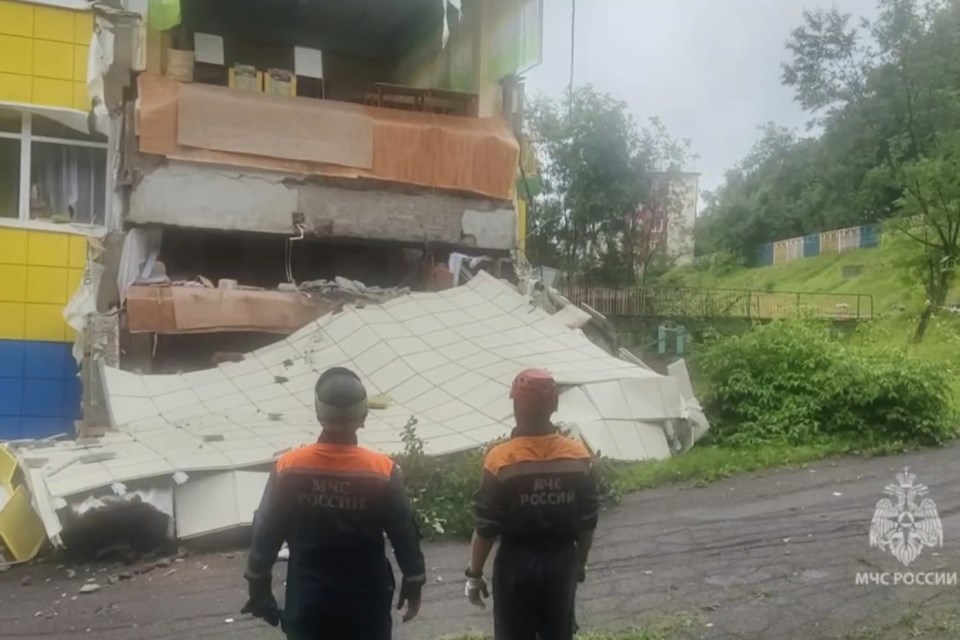MOSCOW (AP) — A powerful earthquake struck Wednesday off Russia’s Far East coast, flooding a fishing port with waves from a tsunami, cutting power to a few areas and sending some panicked residents fleeing buildings but causing only a few injuries.
Regional authorities say they were prepared for the 8.8-magnitude quake and the subsequent waves, and moved quickly to keep residents safe. They introduced a state of emergency in some areas, but said there was no major damage.
Here is what to know about the Russian areas hit by the quake and tsunami:
Kamchatka peninsula
Dubbed the “land of fire and ice,” Kamchatka is one of the most active volcanic regions on Earth. It has about 300 volcanoes, with 29 of them still active, according to NASA’s Earth Observatory. Quakes and tsunamis regularly strike the peninsula that lies close to an ocean trench where two tectonic plates meet.
The 1,200-kilometer (750-mile)-long peninsula nine time zones east of Moscow faces the Pacific Ocean on its east and the Sea of Okhotsk along its west coast. Kamchatka and a few nearby islands have a population of about 290,000 with about 162,000 of them living in the regional capital of Petropavlovsk-Kamchatsky in Avacha Bay on the peninsula’s southeast.
There are few roads on the peninsula, and helicopters are the only way to reach most areas. Fishing is the main economic activity.
The tallest volcano is Klyuchevskaya Sopka (4,750 meters or 15,584 feet), the largest active volcano in the Northern Hemisphere. Observers heard explosions and saw streams of lava on its western slopes, according to the Kamchatka branch of the Russian Academy of Sciences’ geophysical service. It last erupted in 2023.
A nuclear submarine base
Kamchatka hosts a major Russian nuclear submarines base in Vilyuchinsk in Avacha Bay. The base is home to five state-of-the-art Borei-class submarines armed with nuclear-tipped intercontinental ballistic missiles, a key element of the country’s nuclear triad of land, sea and air forces.
Vilyuchinsk also hosts several nuclear-powered attack submarines, including some of the most advanced in the Russian navy’s inventory.
The quake raised questions about whether the Vilyuchinsk base suffered any damage. The Defense Ministry hasn’t reported any problems, and there was no independent way to check on the condition of the base that is closed to outsiders.
Military experts say, however, that Avacha Bay protects the base from tsunami waves and note it was constructed to take into account the seismic threat.
Retired Russian navy Capt. Vasily Dandykin told the daily Moskovsky Komsomolets that all facilities in Vilyuchinsk were designed to withstand earthquakes. He said the quake posed no threat to the nuclear submarines.
Russian media have reported the base is expected to serve as the home for nuclear-powered submarines intended to carry nuclear-armed and atomic-powered Poseidon torpedoes that have intercontinental range and are designed to explode near coastlines and cause what some military experts describe as a radioactive tsunami. The Poseidon has been veiled in secrecy, but President Vladimir Putin said last year that its tests were nearing completion.
The Kuril islands
The four volcanic islands, known in Russia as the Kurils, stretch between Kamchatka and the Japanese island of Hokkaido.
The islands were captured by the Soviet Union from Japan in the closing days of World War II. Japan asserts territorial rights to the islands it calls the Northern Territories, and the dispute has kept the countries from signing a peace treaty
The islands have a population of about 20,000, and the local economy is based on fishing. The Russian military has bolstered its presence in the area, refurbishing a Soviet-era air base and other outposts.
The impact of the quake and tsunami
The 8.8-magnitude quake, centered about 120 kilometers (75 miles from Petropavlovsk-Kamchatsky, struck at 11:24 a.m. local time (2324 GMT Tuesday, 7:24 p.m. EDT Tuesday) at a depth of about 21 kilometers (13 miles), according to the U.S. Geological Survey. Multiple aftershocks as strong as 6.9 magnitude followed.
The earthquake appeared to be the strongest on record since the 9.1 magnitude earthquake off northeastern Japan in March 2011 that caused a massive tsunami. Only a few stronger earthquakes have ever been measured anywhere.
Authorities on Kamchatka and the Kurils said they were prepared for a major quake for a long time and acted quickly to protect the population. Officials on Kamchatka said several people were injured, including a hospital patient injured while jumping out of a window. All were in satisfactory condition.
Municipal workers inspected hundreds of apartment buildings but didn't find any signficant damage that would warrant evacuating residents.
Petropavlovsk-Kamchatsky was protected from big tsunami waves by its location on Avacha Bay. In Severo-Kurilsk, the Kurils' main city, tsunami waves as high as 6 meters (over 3 feet) flooded the fishing port and swept fishing boats out to sea.
Vladimir Isachenkov, The Associated Press


